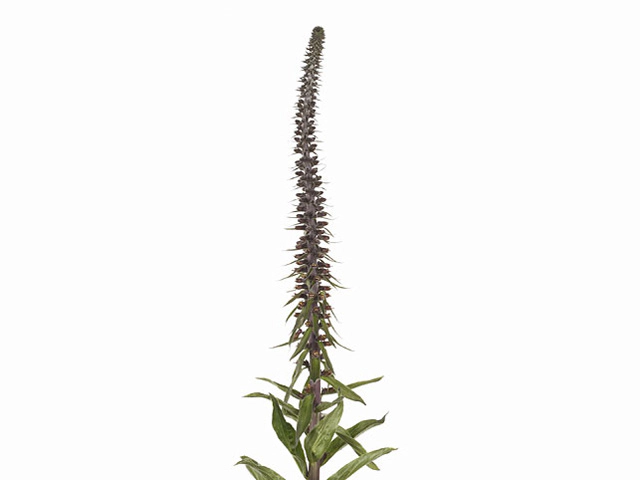Digitalis parviflora

| Leaf tip | Pointed/acute |
| Flower color | Brown-medium brown-175A |
| Leaf, general shape | Lanceolate |
| Flower diameter | 1 - 10 mm |
| Inflorescence | Raceme |
| Leaf size | 15 - 20 cm |
| Light conditions | Semi-shades; Sunny |
| Leaf, main color | Dark green |
| Toxicity (if consumed) | Highly toxic |
| Moisture requirements | Moist; Well-drained |
| Soil type | Humus rich |
Digitalis parviflora, also known as small-flowered foxglove, is a fascinating plant with its unique characteristics and alluring beauty. This article will delve into the various aspects of Digitalis parviflora, including its leaf structure, flower color, general shape, size, light and moisture requirements, soil type, and toxicity if consumed.
One striking feature of Digitalis parviflora is its lanceolate-shaped leaves, which taper to a pointed or acute tip. These leaves, measuring 15 to 20 cm in length, boast a rich, dark green hue. They provide a stunning backdrop to the plant's ephemeral flowers.
Speaking of flowers, the small-flowered foxglove exhibits an intriguing color scheme. Its delightful blooms showcase shades of brown, ranging from medium brown to a captivating 175A hue. These dainty flowers, with a diameter between 1 and 10 mm, are arranged in a raceme inflorescence, creating a visually appealing display.
When it comes to growing conditions, Digitalis parviflora requires a balance of sunlight and shade. It thrives in semi-shaded areas but is equally comfortable basking in the sun's rays. Providing optimal light conditions ensures that this plant flourishes and displays its gorgeous foliage and flowers to their full potential.
To keep Digitalis parviflora healthy, the moisture requirements must be met. It prefers moist soil that is well-drained, allowing its roots to breathe and preventing waterlogging that could lead to the plant's decline. By maintaining the right moisture levels, gardeners can ensure the thriving growth of their small-flowered foxglove.
When it comes to soil, Digitalis parviflora appreciates a humus-rich environment. The presence of organic matter in the soil enhances its fertility and moisture-retention capability, providing an ideal foundation for the plant's growth.
While Digitalis parviflora is undoubtedly aesthetically pleasing, it is important to note that it harbors a potentially harmful secret. The plant is highly toxic if consumed. Therefore, caution must be exercised around children and pets to avoid any potential ingestion that could lead to severe health consequences. It is always wise to take necessary precautions and keep this beautiful plant out of reach from curious mouths.
In conclusion, Digitalis parviflora is a stunning plant with lanceolate-shaped leaves, highlighted by its intriguing color scheme ranging from medium brown to 175A. It thrives in semi-shades and sunny areas, requiring well-drained, moist soil enriched with humus. However, it is crucial to remember that this plant poses significant toxicity risks if consumed. By understanding and providing the proper care, gardeners can enjoy the beauty of Digitalis parviflora while ensuring the safety of their surroundings.
Market availability index by month:
| Jan. | Feb. | Mar. | Apr. | May | Jun. | Jul. | Aug. | Sep. | Oct. | Nov. | Dec. |
|---|---|---|---|---|---|---|---|---|---|---|---|
| - | 3 | 3 | - | - | 4 | 3 | 3 | 3 | - | - | - |